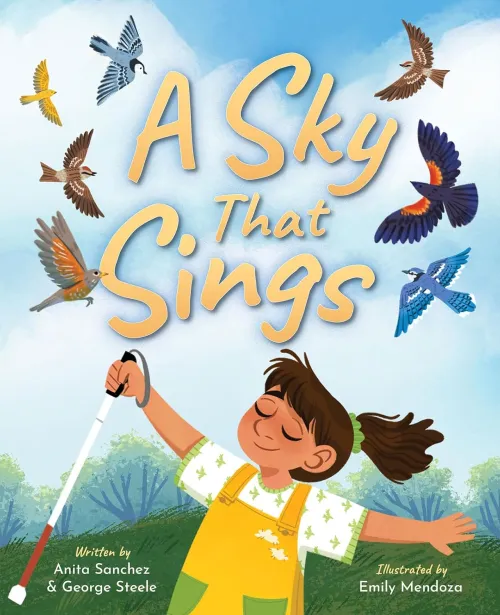Share this Book
Using your ears is important in getting to know birds! Get students thinking about how and why birds vocalize and what we humans actually hear. Explain that each bird species has its own unique songs and calls, and that it’s possible to identify birds just by listening—even without seeing them. Using the video and sound resources at Cornell Lab’s All About Birds, search for birds that are featured in A Sky That Sings. Play the audio or video for students, letting kids know which bird they are listening to. Ask them to listen carefully and then describe each of the birds’ songs or calls. Then have students listen again, without telling them which bird they are listening to. Can they identify the bird?
In the book, Mia uses her sense of hearing along with mnemonics, which are memory tools that use words or phrases to mimic the rhythm or sound of a bird’s call. These can be silly or catchy, but they make the sounds easier to remember. Talk with students about the mnemonics shared in A Sky That Sings and listen again to the bird audio. Do these mnemonics sound like the birds? Do they have ideas for other mnemonics that would be more helpful to them in identifying these birds?
Next, head outside with students for some bird-listening to locate and identify local feathered friends! Have everyone sit quietly with eyes closed without talking. Ask students to focus on all the sounds around them, not just birds: rustling leaves, distant traffic, insect buzzes, etc. Have them jot down what they hear after sitting for 10 minutes then talk about the sounds they encountered: Did they hear more than one sound at the same time? Were there any sounds they couldn’t figure out? Was there ever a moment of total quiet?
Once students are tuned in, shift their focus to bird sounds. As they listen for birds, ask them to write down words or phrases that match the rhythm or tone of each bird’s song, and try to identify which bird it might be. You can use the Merlin Bird ID app, which includes a Sound ID feature, to help students confirm what they’re hearing in real time and deepen their understanding of the birds around them.
Questions for Discussion or Reflective Writing
- How does Mia experience the world differently from her aunt? What do you notice in the illustrations about how Mia experiences the world around her?
- How can engaging all your senses help you better understand your environment? How does that work for Mia?
- Why do you think Mia is so passionate about bird-listening? What is an activity that you feel passionate about? Why? How does sharing your passion with others make you feel?
- What does paying attention to the sounds in your surroundings help you learn about?
- Why do you think the author chose the title A Sky That Sings? What does that phrase mean to you after reading the book?
Related Resources
A Sky that Sings Teacher’s Guide from Lee & Low Books
Bird Buddies from Start with a Book
Bird Guide from Cornell Lab All About Birds
Merlin Bird ID app from Cornell Lab
More Titles to Try
-
Bird Talk: What Birds Are Saying and Why
by Lita Judge
-
Listen
by Gabi Snyder; illustrated by Stephanie Graegin
-
My Ocean Is Blue
by Darren Lebeuf; illustrated by Ashley Barron
-
Noisy Bird Sing-Along
by John Himmelman
-
Song in the City
by Daniel Bernstrom
-
Thukpa for All
by Praba Ram and Sheela Preuitt; illustrated by Shilpa Ranade
Stay on top of current education news


